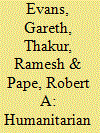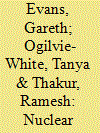| Srl | Item |
| 1 |
ID:
060795


|
|
|
|
|
| Publication |
Mar-Apr 2005.
|
|
|
|
|
|
|
|
|
|
|
|
|
|
|
|
| 2 |
ID:
120049


|
|
|
| 3 |
ID:
009008


|
|
|
|
|
| Publication |
June 1, 1995.
|
| Description |
11-13
|
|
|
|
|
|
|
|
|
|
|
|
|
|
|
|
| 4 |
ID:
191946


|
|
|
|
|
| Publication |
Canberra, CNND, 2015.
|
| Description |
xxv, 305p.pbk
|
| Standard Number |
9780987487919
|
|
|
|
|
|
|
|
|
|
|
|
Copies: C:1/I:0,R:0,Q:0
Circulation
| Accession# | Call# | Current Location | Status | Policy | Location |
| 060436 | 327.1747/EVA 060436 | Main | On Shelf | General | |
|
|
|
|
| 5 |
ID:
084262


|
|
|
|
|
| Publication |
2008.
|
| Summary/Abstract |
How far did the unanimous agreement on the responsibility to protect at the 2005 UN World Summit really mark the international community's acceptance of a new norm supporting collective action - including ultimately military action - when governments through either incapacity or ill-will fail to protect their own people from genocide, war crimes, ethnic cleansing and crimes against humanity? This article describes the rapid initial emergence and acceptance of the concept, but also the subsequent denial and evasion by a number of governments of the commitments they signed up to in 2005. It addresses the five main conceptual misunderstandings and misapprehensions evident in the public debate that need to be overcome if the argument in support of the responsibility to protect is to be won.
|
|
|
|
|
|
|
|
|
|
|
|
|
|
|
|
| 6 |
ID:
053643


|
|
|
|
|
| Publication |
2004.
|
| Description |
p59-81
|
| Summary/Abstract |
No universally accepted practice currently governs the use of military force: states are going to war when they should not be, and not taking military action when they should. Available international law tools are not the problem: Chapter VII and Article 51 of the UN Charter, properly applied, between them enable the full range of necessary responses – both reactive and preventive – to all likely future security threats. What is needed, in the Security Council and elsewhere, is better process to maximise the chances of reaching consensus as to when it is right to fight. Five criteria of legitimacy should be accepted as guidelines in all cases: seriousness of threat, proper purpose, last resort, proportional means and balance of consequences.
|
|
|
|
|
|
|
|
|
|
|
|
|
|
|
|